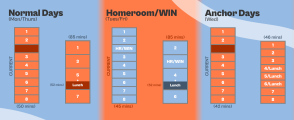How to read your nutrition labels: Is what we eat actually “healthy?”
Nutrition labels. They are plastered on every store-bought product we consume. Many overlook these bite-sized labels, despite them being one of the most important aspects of made-for-purchase food. A lot of the products deemed “healthy” with labels that advertise them as “all natural,” “non-GMO,” and “whole grain” are a facade一 in reality, many of them contain ingredients that are harmful to our bodies, often including chemicals and unhealthy amounts of sugar or fat.
Deciphering the nutritional value of your food and what these labels really mean can be tricky, and searching online can be time-consuming when all you really want is to chow down on a quick granola bar. We’ve put together three important tips on how to read the labels we often ignore to help you decipher what’s good for you and what may not be the best choice.
Be conscious of the serving size. Sitting down after school and eating half a box of Cheez-Its after a long day can seem like “self care,” but in actuality, you may be eating more than you realize. Oftentimes, how much we want to eat is a lot different than how much we should eat. The “Nutrition Facts” on the side of the packaging is in proportion to the serving size, so make sure to take that into consideration when you crave four Danimals Drinkable Yogurts, as nine grams of sugar can quickly turn into 36.
Know how much you need. We all know that ingredients like sugar and sodium should be eaten in moderation, but it’s hard to know how much is too much when processed foods include unhealthy portions of these ingredients. The American Heart Association suggests that women consume 6g of added sugar and men consume 9g of added sugar daily, out of a daily total of 25g of overall sugar for women and 37.5 for men. With so many products laden with artificial sweeteners and sugars, it’s easy to go over the suggested amount in a matter of bites. Additionally, low-fat foods often contain more sugar to enhance the flavor, so be sure to be conscious of that. Besides the obvious candy and fruit juice, common foods like BBQ sauce, ketchup, salad dressing and yogurt contain a lot more sugar than most imagine. Sodium is another ingredient to watch out for, as the AHA recommends no more than 2,300 mg daily. Pizza, cottage cheese, soup and certain sauces can contain unhealthy amounts of sodium, so moderating how much sodium is in these common foods is beneficial.
Become familiar with the terms being used. What is the difference between saturated and trans fat? What is dietary fiber? Does “fat free” really mean there is no fat? What is this ingredient I can’t pronounce? (hint: saturated fat raises high-density lipoprotein and low-density lipoprotein, while trans fat increases cholesterol; dietary fiber is the portion of plant-based food that cannot be broken down entirely by the human digestive system; fat-free means that a product contains less than 0.5g of fat per serving.) A lot of the time, we’re unsure about what we’re putting into our bodies because we don’t know what the label is saying. A good rule of thumb is to try to pronounce the chemicals on the ingredients part of the label- if you can’t pronounce three or more ingredients, it’s likely highly processed. Another aspect to watch out for are claims like “all natural.” The Food and Drug Administration considers natural food to be food that does not contain anything artificial or synthetic. This regulation, however, does not account for the use of pesticides or whether or not the method of production was natural. Many are unaware of crucial bits of information or assume what things mean instead of taking the time to truly understand what they’re consuming, and this often leads to falsely judging the value of certain foods.
As growing teenagers, forming healthy nutrition habits is extremely important. Benefits of a well-balanced diet include weight loss, reduced risk of cancer, management of diabetes and increased heart health. At times, understanding nutrition labels feels like deciphering hieroglyphics, but understanding what really goes into what we eat is worth the time needed to analyze our food. The products we consume are essential in understanding how we can help our bodies. It’s important to take into consideration the contents of our foods, but to not obsess over the nutritional value of everything we eat.

Lauren Somers is a senior at Naperville North and is super excited to continue writing for The North Star for her second year. She can’t wait to try...












fitoru • Jan 19, 2020 at 5:14 pm
Thanks for the insights. This article is very helpful.